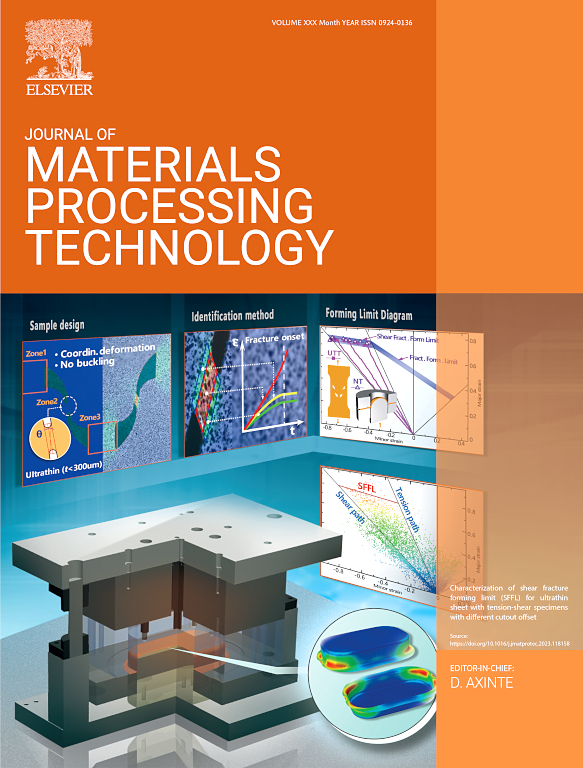基于热均匀性的向下定向凝固技术控制单晶涡轮叶片凝固过程中的迟滞效应
IF 7.5
2区 材料科学
Q1 ENGINEERING, INDUSTRIAL
Journal of Materials Processing Technology
Pub Date : 2025-07-11
DOI:10.1016/j.jmatprotec.2025.118984
引用次数: 0
摘要
迟滞效应是单晶(SC)铸件定向凝固过程中使用圆形模具和鼓形加热和冷却系统的传统工艺时出现的一个基本特征。这种影响主要是负责形成雀斑和杂粒缺陷的SC铸件,有助于高废品率。为有效控制磁滞效应,提出了一种基于热均匀性的向下定向凝固新技术。在控制雀斑和杂散晶粒缺陷方面,将该工艺与传统的高速凝固(HRS)工艺进行了系统的比较,并通过实验和仿真方法验证了其控制迟滞效应的能力。结果表明:由于TUDWDS凝固方式与重力方向一致,可以有效地防止纵向溶质对流,从而完全消除了雀斑;此外,与HRS工艺相比,其平行加热和冷却系统提供了更均匀分布的温度场,显著减少了SC铸件中的杂散晶粒。这些结果表明,TUDWDS工艺具有很强的控制迟滞效应的能力。此外,该工艺具有更强的传热方向,增强了定向凝固过程中的整体换热效果和热梯度,进一步减轻了低热梯度相关的缺陷。因此,该工艺在SC铸件的工业生产中具有广泛的应用前景。本文章由计算机程序翻译,如有差异,请以英文原文为准。
A thermal uniformity-based downward directional solidification technology for controlling the hysteresis effect during solidification of single-crystal turbine blades
The hysteresis effect is an essential characteristic that arises during the directional solidification of single crystal (SC) castings when using traditional processes that employ circular molds and drum-shaped heating and cooling systems. This effect is primarily responsible for the formation of freckles and stray grain defects in the SC castings, contributing to a high rejection rate. To effectively control the hysteresis effect, this paper proposes a novel thermal uniformity-based downward directional solidification (TUDWDS) technology. This process is systematically compared with a conventional high-rate solidification (HRS) process in terms of controlling freckle and stray grain defects, validating its capability to manage the hysteresis effect through both experimental and simulation methods. The results indicate that the TUDWDS process completely eliminates freckles by preventing longitudinal solute convection due to its solidification mode aligning with gravity. Additionally, its parallel heating and cooling systems provide a more uniformly distributed temperature field compared to the HRS process, significantly reducing stray grains in SC castings. These findings suggest that the TUDWDS process exhibits a strong capability to control the hysteresis effect. Moreover, the novel process facilitates stronger heat transfer directions, which enhances the overall heat exchange effect and thermal gradients during the directional solidification, further mitigating the defects associated with lower thermal gradients. Therefore, this process shows promising potential for widespread use in the industrial production of SC castings.
求助全文
通过发布文献求助,成功后即可免费获取论文全文。
去求助
来源期刊

Journal of Materials Processing Technology
工程技术-材料科学:综合
CiteScore
12.60
自引率
4.80%
发文量
403
审稿时长
29 days
期刊介绍:
The Journal of Materials Processing Technology covers the processing techniques used in manufacturing components from metals and other materials. The journal aims to publish full research papers of original, significant and rigorous work and so to contribute to increased production efficiency and improved component performance.
Areas of interest to the journal include:
• Casting, forming and machining
• Additive processing and joining technologies
• The evolution of material properties under the specific conditions met in manufacturing processes
• Surface engineering when it relates specifically to a manufacturing process
• Design and behavior of equipment and tools.
 求助内容:
求助内容: 应助结果提醒方式:
应助结果提醒方式:


